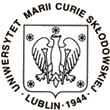

 |
 |
 |
|
Christelle Schmitt
GSI, Darmstadt Investigation of dissipation in nuclear fissionIn the early 1980’s, the striking disagreement between measured and predicted pre-scission particle multiplicities indicated that including dissipation in the description of nuclear fission is necessary what has originally been proposed by Kramers more than 60 years ago. This presentation is devoted to the investigation of dissipation in two extreme regimes of energy from a theoretical as well as from an experimental point of view. In a first step multimodal fission of the compound nucleus 227Pa is studied using a fusion-fission reaction at low excitation energy. The experimental data, obtained in a campaign performed at the JINR in Dubna, are compared to the predictions of the fission dynamics model we developped and which is based on the solution of the multidimensional Langevin equation coupled to the Master equations in order to take particle evaporation all along the deformation towards the scission point into account. The confrontation theory-experiment will permit us to improve our theory and to extract information on the temperature dependence of nuclear friction at low energy. In the second part we investigate very high excitation energies. In this framework fission after peripheral collisions of relativistic heavy ions is studied at GSI. The experimental set-up and its ability to produce, identify and separate around 40 radioactive beams (from uranium to astatine) and to determine the nuclear charge of both fragments of one fission event are presented. From the theoretical side, an analytical approximation of the exact solution of the Fokker-Planck equation is used for describing the time-dependence of the fission decay width and allows us to estimate the value of the dissipation coefficient over a wide range of fissioning nuclei. This presentation points out new clear experimental signatures of nuclear dissipation in two extreme excitation energy regimes which were never used for this purpose up to now.
| ||
Last modificated: 2003-09-22

